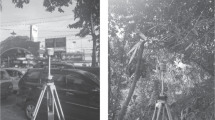Abstract
Environmental monitoring tasks over large spatial coverage often necessitate acquiring sample/reference positions using the global navigation satellite systems in order to optimise operational costs. Often, such tasks occur within dense tree coverage where the navigation signals are blocked. For tasks requiring accurate positions under limited resources, this becomes undesirable, especially if the operation is to be carried out while in motion, i.e. “on the fly” or “real-time kinematic”. Even with this realisation, numerous studies investigating the potential of combining the constellations of these navigation systems mostly focus on their structural aspects, leaving the exploitation of the multi-signal constellation under dense tree cover largely untested. Using a test experiment of a station declared unusable due to dense tree cover at Curtin University (Australia), this study evaluates whether sample positions can be improved using multi-constellation global navigation satellite systems where poor sky visibility exist due to tree coverage. Positioning improvement measures are (1) geometrical gain measured by position dilution of precision, (2) horizontal and vertical uncertainty estimates and (3) positional accuracies determined through the comparison of the obtained control positions and their known values. The results indicate significant positioning improvement when all constellations are utilised in comparison with using Global Positioning System alone in dense tree cover environments, i.e. geometrical gain of as much as 72%, horizontal precisions by about 40%, vertical precisions of up to 50% and 94% accuracy improvement. This study thus opines that utilising full global navigation satellite’s constellation would benefit environmental monitoring tasks carried out under dense tree cover.



Similar content being viewed by others
References
Awange JL (2012) Environmental monitoring using GNSS: global navigation satellite systems. Springer, Berlin
Awange JL (2018) GNSS environmental sensing. Springer, Berlin
Awange J, Kiema JB (2013) Environmental geoinformatics. Monitoring and management. Springer, Berlin
Awange J, Kiema JB (2019) Environmental geoinformatics. Extreme hydro-climatic and food security challenges: exploiting the big data. Springer, Berlin
El-naggar A (2011) Enhancing the accuracy of GPS point positioning by converting the single frequency data to dual frequency data. Alex Eng J 50:237–243. https://doi.org/10.1016/j.aej.2011.03.003
European Commission and European Space Agency (2002) Galileo mission high level definition, 3rd issue. http://ec.europa.eu/dgs/energy_transport/Galileo/doc/Galileo_hld_v3_23_09_02.pdf. Accessed 11 Feb 2019
Ferrão PFFN (2016) Positioning with combined GPS and GLONASS observations (masters’ thesis). https://fenix.tecnico.ulisboa.pt/downloadFile/395145496449/thesis.pdf. Accessed 11 Feb 2019
Goncalves R, Awange JL (2017) Evaluation of three mostly used GNSS-based shoreline monitoring methods to support integrated coastal zone management policies. J Surv Eng. https://doi.org/10.1061/(ASCE)SU.1943-5428.0000219
Gonçalves R, Awange J, Krueger C (2013) GNSS-based monitoring and mapping of shoreline position in support of planning and management of Matinhos/PR (Brazil). J Glob Position Syst 11:156–168
Goodman JA, Ustin SL (2002) Hyperspectral image calibration in a coral reef environment: an empirical approach. In: IEEE international geoscience and remote sensing symposium, vol 1. IEEE, pp 243–245
Goossens R, De Wulf A, Bourgeois J, Gheyle W, Willems T (2006) Satellite imagery and archaeology: the example of CORONA in the Altai Mountains. J Archaeol Sci 33(6):745–755
Hammond WC, Brooks BA, Bürgmann R, Heaton T, Jackson M, Lowry AR, Anandakrishnan S (2010) The scientific value of high-rate, low-latency GPS data, a white paper. http://www.unavco.org/community_science/science_highlights/2010/realtimeGPSWhitePaper2010.pdf. Accessed 06 Mar 2019
Hofman-Wellenhof B, Lichtenegger H, Collins J (2001) Global positioning system: theory and practice, 5th edn. Springer, Wien
Khandu AJ, Wickert J, Schmidt T, Sharifi MA, Heck B, Fleming K (2010) GNSS remote sensing of the Australian tropopause. Clim Change 105(3–4):597–618. https://doi.org/10.1007/s10584-010-9894-6
Landgate (2017) GNSS test network a guide for testing survey grade GNSS systems on the Curtin test network. https://www0.landgate.wa.gov.au/business-and-government/specialist-services/geodetic/related-documents/Testing-Survey-grade-GNSS-systems-on-the-Curtin-Test-Network\_201708.pdf. Accessed 18 Jan 2020
Lau L, Tateshita H, Sato K (2015) Impact of multi-GNSS on positioning accuracy and multipath errors in high-precision single-epoch solutions–a case study in Ningbo China. J Navig 68(5):999–1017. https://doi.org/10.1017/S0373463315000168
Lou Y, Zheng F, Gu S et al (2016) Multi-GNSS precise point positioning with raw single-frequency and dual-frequency measurement models. GPS Solut 20(4):849–862. https://doi.org/10.1007/s10291-015-0495-8
Odijk D (2003) Ionosphere-free phase combinations for modernized GPS. J Surv Eng 129:165–173. https://doi.org/10.1061/(ASCE)0733-9453(2003)129:4(165)
Punia M, Joshi PK, Porwal MC (2011) Decision tree classification of land use land cover for Delhi, India using IRS-P6 AWiFS data. Expert Syst Appl 38(5):5577–5583
Quan Y, Lau L, Roberts GW, Meng X (2016) Measurement signal quality assessment on all available and new signals of multi-GNSS (GPS, GLONASS, Galileo, BDS, and QZSS) with real data. J Navig 69:313–334. https://doi.org/10.1017/S0373463315000624
Schloderer G, Bingham M, Awange JL, Fleming KM (2011) Application of GNSSRTK derived topographical maps for rapid environmental monitoring: a case study of Jack Finney Lake (Perth, Australia). Environ Monit Assess 180(1–4):147–161. https://doi.org/10.1007/s10661-010-1778-8
Swann JW (1999) Advantages and problems of combining GPS with GLONASS (masters’ thesis). http://eprints.nottingham.ac.uk/11284/1/311911.pdf. Accessed 11 Feb 2019
Sweeney International Management Corp (2009) Environmental impact assessment for Kelly Cove Salmon Ltd. proposed aquaculture site relocation for Sand Point, Boston Rock, and Hartz Point. Submitted to NS Department of Fisheries & Aquaculture. SIMCorp. File #SW2008-016, 017 &018
Tiberius C (2011) Global navigation satellite systems. A status update. Hydro Int 15(2):23–27
Torre DA, Caporali A (2015) An analysis of intersystem biases for multi-GNSS positioning. GPS Solut 19(2):297–307. https://doi.org/10.1007/s10291-014-0388-2
Wang L, Groves PD, Ziebart MK (2012) Multi-constellation GNSS performance evaluation for urban canyons using large virtual reality city models. J Navig 65:459–476. https://doi.org/10.1017/S0373463312000082
Acknowledgment
J.L. Awange would like to thank the financial support of the Alexander von Humboldt (AvH) Foundation that supported his time at Karlsruhe Institute of Technology. He is grateful to the good working atmosphere provided by his hosts Prof. Hansjörg Kutterer and Prof Bernhard Heck. Ashty Saleem is grateful for the opportunity offered to him by Curtin University, School of Earth and Planetary Sciences to carry out his postdoctoral studies.
Author information
Authors and Affiliations
Corresponding author
Ethics declarations
Conflict of interest
The authors declared that they have no conflict of interest.
Additional information
Communicated by M. Abbaspour.
Rights and permissions
About this article
Cite this article
Cole, B., Awange, J.L. & Saleem, A. Environmental spatial data within dense tree cover: exploiting multi-frequency GNSS signals to improve positional accuracy. Int. J. Environ. Sci. Technol. 17, 2697–2706 (2020). https://doi.org/10.1007/s13762-020-02634-y
Received:
Revised:
Accepted:
Published:
Issue Date:
DOI: https://doi.org/10.1007/s13762-020-02634-y




